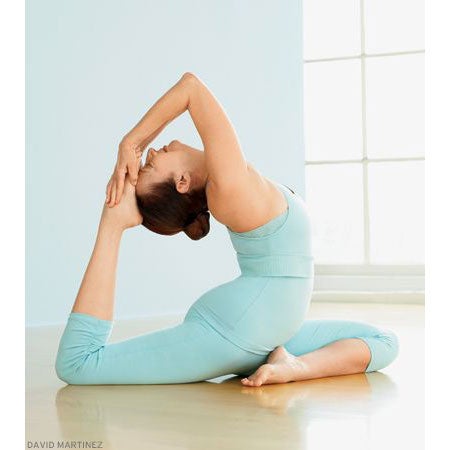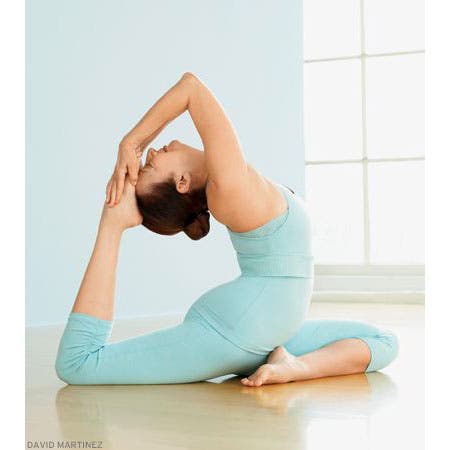Q&A: How Can I Progress in Pigeon Pose?


Q: I have been working with a strap to progress in full pigeon pose. What poses can I do to help me open up my upper back and to progress in pigeon pose?
—Amanda
Lisa Walford’s reply:
In this challenging pose, Eka Pada Rajakapotasana (One-Legged King Pigeon Pose), the chest is puffed up to resemble a king pigeon. And while we certainly don’t walk around strutting our stuff, this asana will energize your adrenal glands and fully open the front of the body.
It is challenging for most people to make the thoracic spine (upper back) flexible. The ribcage attaches to the upper back, which limits its mobility. And the shape of it is naturally convex, which is why we often see the chest collapse in sedentary people. The spine, however, can become supple. And while it is obviously quite difficult, we should distribute the curve evenly throughout the length of the spine in all backbends. Ever see a palm tree in the wind? The curve is long and smooth, starting at the base.
Other factors might contribute to the difficulty you experience in the upper back. If your deep abdominal muscles or the hip flexors are tight, your range of motion may be restricted on the front of your body and spine. Since the lumbar spine is more flexible than the protected thoracic spine, it is possible that while in Eka Pada Rajakapotasana you are pitching the pelvis forward and hinging in the waist rather than lifting the front of the pelvis up off of the thighs. You may not experience any discomfort in your lower back, but you may be folding from the middle back and instigating a gridlock between the lower body and the upper body.
Let’s minimize the use of this floppy area and localize the work in the groins and the upper back by using a chair in Dwi Pada Viparita Dandasana (Two-Legged Inverted Staff Pose.) The support of the chair will enable you to lengthen the core muscles and the hip flexors. The seat of the chair will brace the stiff thoracic spine and help open the chest. For pictures I suggest A Woman’s Book of Yoga and Health by Linda Sparrow and Patricia Walden (Shambhala Press, 2002) and Yoga A Gem for Women, by Geeta Iyengar (Timeless Books, Spokane, Wash., 1990).
Sit backward in a folding chair, with your legs through the space between the seat and backrest. Lie gently back and position yourself so that the seat of the chair supports the back, just below the shoulder blades. Allow your shoulders and head to hang freely off the seat of the chair, and extend your arms overhead. Rest the hands on the floor. To release the deep iliopsoas and hip flexors, straighten the knees and lengthen the buttock bones toward the heels. Draw the shoulder blades in toward the chest and lengthen from the sides of the torso all the way through the fingertips. Relax the jaw and throat. To come out, hold the backrest of the chair with one hand, and push with the other elbow to sit.
Now place several blankets on the floor in front of your chair. Continue as above, but clasp your hands and cradle your head as you would in Headstand. The elbows should be directly underneath the shoulders. If your elbows do not reach the floor, place a rolled sticky mat beneath them. Draw the scapulae in toward the chest as you press the elbows into the blanket. Here the armpits release and the shoulders open.
Be patient with these poses, for it is better to bend like the palm than to break like the oak.
Lisa Walford is a senior intermediate Iyengar Yoga instructor and has been teaching for more than twenty years. She is one of the directors of the Teacher Training Program at Yoga Works, in Los Angeles. She has served on the faculty of the 1990 and 1993 National Iyengar Yoga Conventions and studies regularly with the Iyengars.